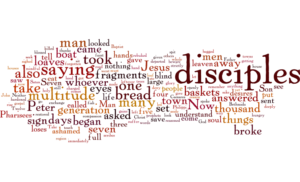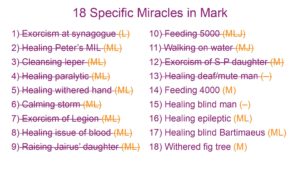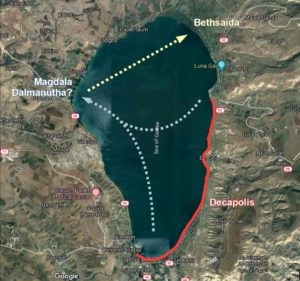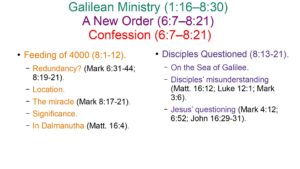The Ministry of Jesus in Galilee
Mark 1:16—8:30
A New King (1:16—3:6).
Kingdom is Near (1:15)
Popularity (1:16-45).
Conflict (2:1—3:6).
Jewish Leaders Reject Him (3:6)
A New Kingdom (3:7—6:6)
Kingdom Has Small Beginnings (4:3)
Continued Conflict (3:7-35).
Parables (4:1-34).
Identity (4:36—6:6).
Jesus’ Town Rejects Him (6:6)
A New Order (6:7—8:21)
Beware of Herod & Pharisees (8:15)
Confession (6:7—8:21).
Limited Commission (6:7-13).
John the Baptist Executed (6:14-29).
Five Thousand Fed (6:30-44).
Jesus Walks on Water (6:45-56).
Opposing Pharisaic Traditions (7:1-23).
Syro-Phoenician Woman (7:24-30).
Deaf Man Healed (7:31-37).
Redundancy? (cf. 6:31-44).
There does seem to be a lot in common with the feeding of the 5000.
Luke and John omit this miracle, but it is found in Matthew.
Many of the details are the same, but there are some key differences.
The number of people present were 4000, not 5000.
The location may be on the other side of the Sea of Galilee (more on location later).
If the location is Decapolis, that implies a Gentile audience.
The amount of food they start with is different (7 loaves, a few small fish).
The amount of food leftover is also different (7 large baskets).

Such redundancies were necessary to reach the thick disciples, as even these two miracles didn’t get through to them (8:19-21).
After all, how many demons have we seen cast out? How many lepers healed? How many people raised from the dead?
The telling of these miracles show Jesus’ power and compassion, and it also reinforces His power and compassion the more times a similar miracle is recorded.
There are also no doubt other lessons we might be able to get from each one, as we’ve already seen.
Not much is known about where this took place.
All we know are a few key phrases.
“In those days” (8:1) indicates this may be close to the same location by the Sea of Galilee in Decapolis where the deaf man was healed—a Gentile region.
“In the wilderness” (8:4) suggests this is an uninhabited region far from towns or villages.
After this, they go to Dalmanutha (8:10), which location is also uncertain, though it is thought to be near Magdala based on Matthew’s account—perhaps on the border of Magdala, north of Tiberias.
Sailing to Dalmanutha/Magdala suggests that this location is not close by.
It is amazing that so much could be so familiar with the feeding of the 5000, yet the disciples still lacked understanding. What hints did they miss that should have tipped them off about Jesus? I count 5.
They are lacking food—the multitude has been with them for three days and probably used up whatever provisions they brought with them.
Jesus shows compassion on them, knowing many have traveled a long way—He feared they would not make it.
What compassion Jesus had on these people, not wanting to them experience the discomfort of physical exertion on an empty stomach!
When one fasts they are prepared mentally and physically for that hardship—these people were not, and there may have been some who could not fast safely, hence possibly fainting on the way home.
Amazingly, the disciples have forgotten what He did in with the 5000, because they ask where they could find food – MISSED HINT #1.
One might say that it’s possible they were trying to ask Jesus to multiply the food again without directly asking Him, but it’s clear later that wasn’t the case (8:17-21).
He then asked how many loaves there were – MISSED HINT #2 (there were 7 with some small fish).
He had the multitude sit down, blessed, and broke the bread – MISSED HINT #3.
Thousands were fed from such a small amount of food – MISSED HINT #4 (4000 this time, but no less miraculous). Matthew says only the men were counted, so actually many more were filled.
Plenty of food was left over – MISSED HINT #5 (7 large baskets).
These hints should have clued them in on who Jesus was and what He was capable of.
He then sent the crowd away to their homes with full bellies.
Significance.
There are some significant factors that really set this apart from the feeding of the 5000.
First, we noted the location was likely in the Gentile region of Decapolis.
This means that His audience was likely made up primarily of Gentiles.
Jesus was able to garner much support from the Gentiles, even willing to feed them miraculously due to His compassion—love took priority.
Again, this further underscores the issues on cleanliness presented in Ch. 7.
It showed He was the bread of life to both the Jews and the Gentiles.
The twelve baskets for the 5000 perhaps represented the twelve tribes of Israel and that Jesus, being the bread of heaven, would fill them up.
The seven baskets for the 4000 perhaps represented filling all the nations as the bread of heaven, since 7 symbolized completeness.
I say “perhaps” because the text doesn’t explicitly make these points.
In Dalmanutha.
Jesus returns to Jewish territory and is immediately accosted by the Pharisees.
They disputed with Him, seeking a sign, testing Him.
Do you suppose they were really seeking a sign so they could believe in Him?
No, we know that they are not asking from an honest place.
Jesus performed signs and miracles all the time, yet they were not willing to accept those.
They were spiritually blinded to who and what Jesus was and Jesus signed with frustration at their hardened hearts—but they weren’t the only ones!
Then He states that no sign will be given this generation.
In the other accounts, we note that He says, “No sign shall be given to it except the sign of the prophet Jonah” (Matt. 16:4).
In this He predicted His death and resurrection, relating it to Jonah’s time in the belly of the big fish.
Expecting a miracle whenever someone offers a word from the Lord was expected for it confirmed that what they said did, indeed, come from the Lord.
But Jesus clearly saw their hypocrisy, knowing they would not accept any sign He showed them, especially since they had yet to accept any others.
How many signs did He need to show them?!
They simply had to wait for His resurrection.



